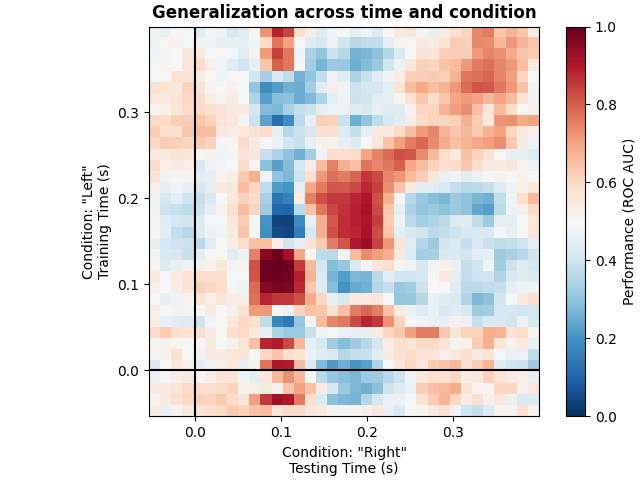Note
Go to the end to download the full example code.
Decoding sensor space data with generalization across time and conditions#
This example runs the analysis described in [1]. It illustrates how one can fit a linear classifier to identify a discriminatory topography at a given time instant and subsequently assess whether this linear model can accurately predict all of the time samples of a second set of conditions.
# Authors: Jean-Rémi King <jeanremi.king@gmail.com>
# Alexandre Gramfort <alexandre.gramfort@inria.fr>
# Denis Engemann <denis.engemann@gmail.com>
#
# License: BSD-3-Clause
# Copyright the MNE-Python contributors.
import matplotlib.pyplot as plt
from sklearn.linear_model import LogisticRegression
from sklearn.pipeline import make_pipeline
from sklearn.preprocessing import StandardScaler
import mne
from mne.datasets import sample
from mne.decoding import GeneralizingEstimator
print(__doc__)
# Preprocess data
data_path = sample.data_path()
# Load and filter data, set up epochs
meg_path = data_path / "MEG" / "sample"
raw_fname = meg_path / "sample_audvis_filt-0-40_raw.fif"
events_fname = meg_path / "sample_audvis_filt-0-40_raw-eve.fif"
raw = mne.io.read_raw_fif(raw_fname, preload=True)
picks = mne.pick_types(raw.info, meg=True, exclude="bads") # Pick MEG channels
raw.filter(1.0, 30.0, fir_design="firwin") # Band pass filtering signals
events = mne.read_events(events_fname)
event_id = {
"Auditory/Left": 1,
"Auditory/Right": 2,
"Visual/Left": 3,
"Visual/Right": 4,
}
tmin = -0.050
tmax = 0.400
# decimate to make the example faster to run, but then use verbose='error' in
# the Epochs constructor to suppress warning about decimation causing aliasing
decim = 2
epochs = mne.Epochs(
raw,
events,
event_id=event_id,
tmin=tmin,
tmax=tmax,
proj=True,
picks=picks,
baseline=None,
preload=True,
reject=dict(mag=5e-12),
decim=decim,
verbose="error",
)
Opening raw data file /home/circleci/mne_data/MNE-sample-data/MEG/sample/sample_audvis_filt-0-40_raw.fif...
Read a total of 4 projection items:
PCA-v1 (1 x 102) idle
PCA-v2 (1 x 102) idle
PCA-v3 (1 x 102) idle
Average EEG reference (1 x 60) idle
Range : 6450 ... 48149 = 42.956 ... 320.665 secs
Ready.
Reading 0 ... 41699 = 0.000 ... 277.709 secs...
Filtering raw data in 1 contiguous segment
Setting up band-pass filter from 1 - 30 Hz
FIR filter parameters
---------------------
Designing a one-pass, zero-phase, non-causal bandpass filter:
- Windowed time-domain design (firwin) method
- Hamming window with 0.0194 passband ripple and 53 dB stopband attenuation
- Lower passband edge: 1.00
- Lower transition bandwidth: 1.00 Hz (-6 dB cutoff frequency: 0.50 Hz)
- Upper passband edge: 30.00 Hz
- Upper transition bandwidth: 7.50 Hz (-6 dB cutoff frequency: 33.75 Hz)
- Filter length: 497 samples (3.310 s)
We will train the classifier on all left visual vs auditory trials and test on all right visual vs auditory trials.
clf = make_pipeline(
StandardScaler(),
LogisticRegression(solver="liblinear"), # liblinear is faster than lbfgs
)
time_gen = GeneralizingEstimator(clf, scoring="roc_auc", n_jobs=None, verbose=True)
# Fit classifiers on the epochs where the stimulus was presented to the left.
# Note that the experimental condition y indicates auditory or visual
time_gen.fit(X=epochs["Left"].get_data(copy=False), y=epochs["Left"].events[:, 2] > 2)
0%| | Fitting GeneralizingEstimator : 0/35 [00:00<?, ?it/s]
6%|▌ | Fitting GeneralizingEstimator : 2/35 [00:00<00:00, 43.91it/s]
9%|▊ | Fitting GeneralizingEstimator : 3/35 [00:00<00:00, 37.69it/s]
11%|█▏ | Fitting GeneralizingEstimator : 4/35 [00:00<00:00, 34.31it/s]
17%|█▋ | Fitting GeneralizingEstimator : 6/35 [00:00<00:00, 40.45it/s]
23%|██▎ | Fitting GeneralizingEstimator : 8/35 [00:00<00:00, 44.34it/s]
31%|███▏ | Fitting GeneralizingEstimator : 11/35 [00:00<00:00, 52.25it/s]
40%|████ | Fitting GeneralizingEstimator : 14/35 [00:00<00:00, 58.04it/s]
49%|████▊ | Fitting GeneralizingEstimator : 17/35 [00:00<00:00, 62.46it/s]
57%|█████▋ | Fitting GeneralizingEstimator : 20/35 [00:00<00:00, 65.93it/s]
63%|██████▎ | Fitting GeneralizingEstimator : 22/35 [00:00<00:00, 65.15it/s]
71%|███████▏ | Fitting GeneralizingEstimator : 25/35 [00:00<00:00, 67.84it/s]
77%|███████▋ | Fitting GeneralizingEstimator : 27/35 [00:00<00:00, 66.96it/s]
86%|████████▌ | Fitting GeneralizingEstimator : 30/35 [00:00<00:00, 69.19it/s]
94%|█████████▍| Fitting GeneralizingEstimator : 33/35 [00:00<00:00, 71.07it/s]
100%|██████████| Fitting GeneralizingEstimator : 35/35 [00:00<00:00, 71.82it/s]
100%|██████████| Fitting GeneralizingEstimator : 35/35 [00:00<00:00, 68.55it/s]
